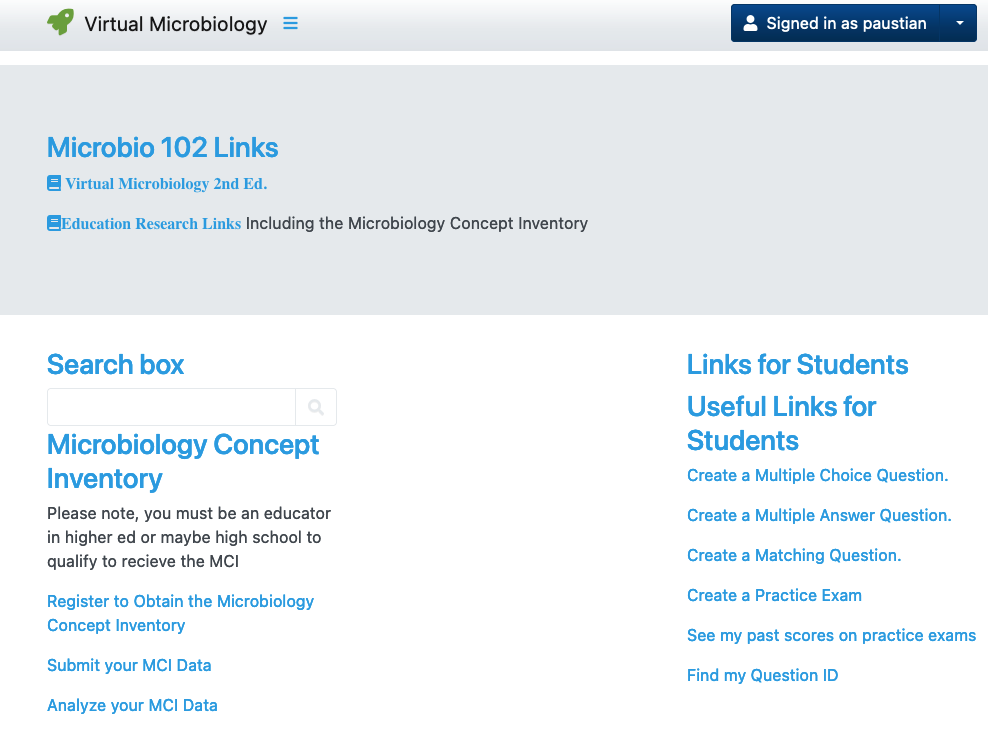Search box
Microbiology Concept Inventory
Please note, you must be an educator in higher ed or maybe high school to qualify to recieve the MCI
( 2729 Reads)
Please follow these directions when writing your exam questions.
Questions will be submitted to a website and saved in a database for all participants to see. Therefore you can see the types of questions your fellow students are asking and can use them to practice for the exam. I will take these and choose the best for the exam. I will also be responsible for writing 50-70% of the exam, but 30-50% of it will come from you.
I reserve the right to edit questions or throw them out. If you write a particularly bad question that does not follow the guidelines (see below), you don't get the bonus points. (I accept most questions, and you can rewrite the question to get credit.) So start early!
To help you write good questions, please read the guide at Vanderbilt University. It is full of great suggestions for writing good multiple-choice questions. Instead of reinventing the wheel, I will direct you there. You can skip the first part and start reading at Constructing an Effective Stem.
Some additional notes
- Each question must have five alternatives.
- Avoid writing low-level questions. For example, questions that only require rote memorization. Instead, write questions that require the reader to have certain knowledge and apply it. This first example is testing the study guide question:
What are the major differences between bacterial envelopes (e.g., membranes and cell walls, etc.) in Gram-positive and Gram-negative bacteria?
The following question only requires rote memorization. It's a usable question but could be better. (Correct answer is C)
Q1. The Gram-positive cell wall is mostly made up of
A. LPS
B. phospholipids
C. peptidoglycan
D. mycolic acids
E. porins
However, this second example requires the student to know both Gram-positive and Gram-negative structures and compare them to arrive at the correct answer (A). It is a better question.
Q1.A major difference between Gram-negative and Gram-positive cell wall structures is that
A. Gram-negative cells contain LPS
B. Gram-negative cells contain teichoic acid
C. Gram-negative cells make mycolic acids
D. Gram-positive cells contain porins
E. Gram-negative cells are thicker
OK, you have your question coded. How do you enter it into the database? Please go to my exam writing website and create a new account. Once you are logged in, you can then start writing questions. You only need to create an account the first time you use the site. Here is the interface. (Note that you can also log in with your wisc.edu address as a google account)

Choose either Create a Multiple Choice Question, Create a Multiple Answer Question, or Create a Matching Question. That's right, you can write any of these three types of questions. The interface is similar, but pay attention to the directions on the website for each question.
Here is how you would fill out the interface for the above question multiple-choice question.

Here is how that looks in text.:
A major difference between Gram-negative and Gram-positive cell wall structure is that
Gram-negative cells contain LPS|100
Gram-positive cells contain peptidoglycan|0
Gram-positive cells contain porins|0
Gram-negative cells make mycolic acids|0
Gram-negative peptidoglycan layer is thicker|0
Note especially how the answers are filled out. Each answer is written, then a | character is entered, and finally either 0 (incorrect) or 100 (correct) is entered. The pipe character | is located next to the right bracket key just below the delete (or backspace) key on your keyboard. Please do not add A, B, C, D, E before the questions and do not place a % character after the number. Many students do this, and I then have to edit the question. You are also expected to provide an explanation. Begin the explanation by including the study guide question. Then provide a detailed explanation so that your fellow students can understand your reasoning. For the category, Place it in the Module to which your LO belongs (see above).
Please try to have your question submitted to the database as specified. Once you submit your question, it will report back to you an ID number for your question. To get credit for writing a question, you need to do one more thing. Go to this Google Sheet, find your name, and enter in your data. Please put a number corresponding to your Group # (1 – 50) in Group# Ex 1, and the question ID is reported back to you from the database in Question ID Ex 1. The sheet will add up your bonus points for you so don't try to edit that cell (The sheet won't let you anyway.) You will need to log in using your wisc.edu Email address and netid password to access this google sheet. Please do not use your personal Gmail Email address if you have one. If your name is not listed on the sheet, contact me.
You can also practice taking exams using these questions. Go to the home page, click on "Create a practice exam." You will the see an interface where you can pick how many questions you want from each module. Then click Create exam to take the exam. When you are done, click Grade Exam to see how you did.
By the way, some students try to be clever and download all the questions figuring if they memorize them, they will ace the test. This is an inefficient way to study and the interface will prevent you from doing that.
See hidden questions
Create exam from hidden
Modify exam and export